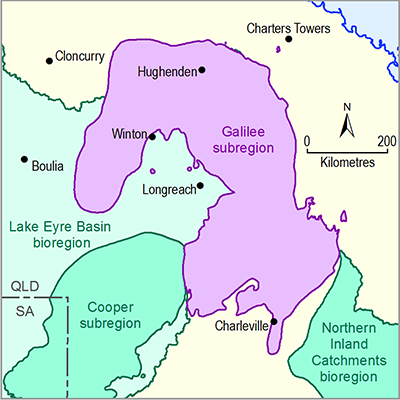Summary
The Galilee subregion is within the Lake Eyre Basin bioregion and is the largest subregion being assessed by the Bioregional Assessment Programme. The Galilee preliminary assessment extent (PAE) occupies diverse environments, from the mountains of the Great Dividing Range through to vast expanses of semi-arid and arid inland Australia. It includes rivers that flow into Kati Thanda – Lake Eyre, the Gulf of Carpentaria, the Pacific Ocean and the Murray–Darling Basin. Key features of the Galilee PAE are its large area, sparse human population density and unpredictable rainfall resulting in natural and human systems driven by resource pulses and boom-bust dynamics. The low human population results in the natural vegetation being relatively unmodified. For BA purposes, a landscape classification was developed to present a conceptualisation of the main biophysical and human systems at the surface of the Galilee PAE and to identify ecosystems with characteristics that are expected to respond similarly to changes in groundwater and/or surface water as a consequence of coal resource development.
The approach taken was developed in close collaboration and with strong guidance from experts that have extensive experience with the landscapes of the PAE both in Queensland and SA and who have contributed to the development of similar classification systems. The classification and typology were developed and refined following a six-step approach. The classification is based on five elements derived from the Australian National Aquatic Ecosystem (ANAE) classification framework involving topography, landform, water source, water type and water availability. In addition, each area was identified as either remnant or non-remnant vegetation based on the Queensland remnant Regional Ecosystem (RE) mapping. This classification produced a typology consisting of 20 landscape classes derived from polygons, 10 landscape classes from lines (streams) and 1 landscape class from points (springs). These 31 landscape classes were then collapsed into 11 broad landscape groups that were either non-water dependent, floodplain or non-floodplain. The non-water-dependent landscape group, ‘Dryland’, dominated the area of the PAE (68.54%). Of the water-dependent landscape classes, 26.52% of the area of the PAE consists of floodplain landscape classes with the remaining 4.87% of the area occupied by non-floodplain, water-dependent landscape classes. For both the floodplain and non-floodplain water-dependent landscape classes, the majority of the area consists of terrestrial groundwater-dependent ecosystems (GDEs).
In this section, each landscape group is described and representative areas are mapped. Nationally listed species and ecological communities are listed. Aspects of water dependency within each landscape group are also documented.

Product Finalisation date
- 2.3.1 Methods
- 2.3.2 Summary of key system components, processes and interactions
- 2.3.3 Ecosystems
- 2.3.4 Baseline and coal resource development pathway
- 2.3.5 Conceptual model of causal pathways
- Citation
- Acknowledgements
- Currency of scientific results
- Contributors to the Technical Programme
- About this technical product
